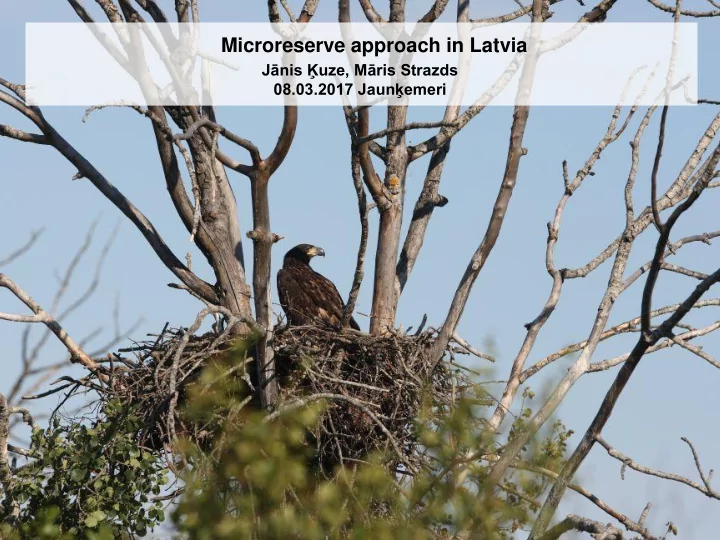

Microreserve approach in Latvia Jānis Ķuze, Māris Strazds 08.03.2017 Jaunķemeri
The concept of MR in a nutshell (1) • Tool for protection of dispersedly breeding species by the designation of small protected areas; • The main function of MR is providing of necessary protection arrangements for the nest site/ breeding habitat; • Buffer zones (BUF) can be established for providing of additional (seasonal) protection during the breeding season.
Natura 2000 sites and microreserves in Latvia in 2010 Total number of MR: 2095; NCA 2010 ( state on 29.12.2010 )
Bird microreserves in Latvia in 2010 Number of bird MR’s in 2011: 1184 (57% from total) with a total area of 33 876 ha, SFS (state on 19.08.2011)
The concept of MR in a nutshell (2) • First MR established in 1973, since 1978 - on more regular basis; • Initially radius around the nest used as a size parameter (now – maximum area in hectares); • Initially duration period was set at 3, later - 10 years (now – not termined); • System has been developed further by introducing of Buffer zones (BUF) – (2001) provide additional (seasonal) protection during the breeding season; • The initial list of species has been widened and now this concept is used for protection of other groups (mammals, birds, fish, reptiles, amphibians, invertebrates, vascular plants, ferns, mosses, lichens, fungi and algae) and protected habitats as well; • Concept of “patchy microreserves” developed in 2009.
List of microreserve bird species* Species MR size Pigmy owl, Tengmalm’s owl, White-backed woodpecker, Middle 2-10 ha spotted woodpecker, Three-toed woodpecker, Green woodpecker, Stock dove, Roller, Osprey, Tawny pipit, Goosander Lesser spotted eagle, Goshawk 5-30 ha Short toed eagle, Black kite, Red kite, Peregrine, Black stork 10-30 ha Eagle owl 20-40 ha Greater spotted eagle, Capercaillie 10-200 ha White tailed eagle 5-60 ha Golden eagle 50-200 ha Species breeding in waterbodies Bittern 2-10 ha Whooper swan R=100 m max. Colonial species breeding in waterbodies Black headed gull, Little gull, White winged tern, Whiskered tern, R=100 m max. Arctic tern, Little tern, Black tern, Common tern *Red marked text: changes in respective regulations of Cabinet of Ministers. New regulations are in force since 01.01.2013
Bufferzones for seasonal restrictions Species Max. area (incl. MR; ha) Capercaillie 500 Greater spotted eagle, White tailed eagle and Golden 300 eagle Black stork, Osprey, Eagle owl, Peregrine, Lesser spotted 100 eagle, Black kite, Red kite, Goshawk, Short-toed eagle, Roller and Stock dove MK 18.12.2012. noteikumi Nr. 940. “Noteikumi par mikroliegumu izveidošanas un apsaimniekošanas kārtību, to aizsardzību, kā arī mikroliegumu un to buferzonu noteikšanu”: https://likumi.lv/doc.php?id=253746
“Solid” microreserves • Traditionally MR were designed as a solid uniform areas, encircled by the BUF; • Not appropriate for the fragmented forest landscape: - Usually includes large areas of young stands, not suitable for breeding of particular species; - Evokes tension between the conservationists and forest owners
“ Patchy ” microreserves In breeding territories where pairs are moving between several subcompartments, protected territories are created in each of those areas, considering potential further resettlings; Microreserves are created using “ patchy approach” – only stands potentially suitable as a breeding grounds are included, younger stands included in the buffer zone MR: 40,3 ha MR: 32,1 ha BUF: 70,0 ha BUF: 130,3 ha
MR: 52,5 ha BUF: 50,0 ha
“Patchy” microreserves: “+” and “ - ” (White-tailed eagle as a case example) MR+BUF MR BUF n Solid MR 89,7 51,3 38,4 30 Patchy MR 100,8 33,3 67,5 13 • Advantages: - Better using of maximum allowed MR territory through the better shaping of area; Stands, not suitable for breeding excluded – easier to argument; - • Shortages: - Modelling of future resettling directions not always successful, “patchy” MR could be the same abandoned through the resettlings ;
Recommend
More recommend